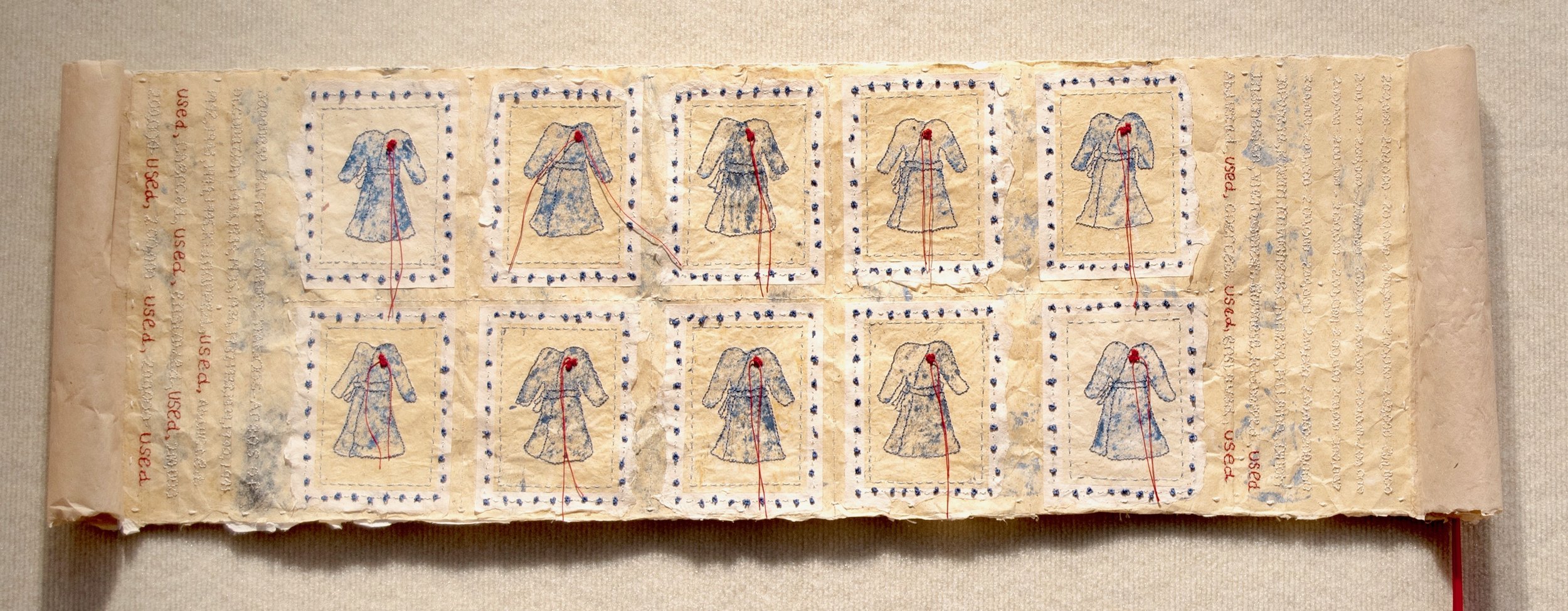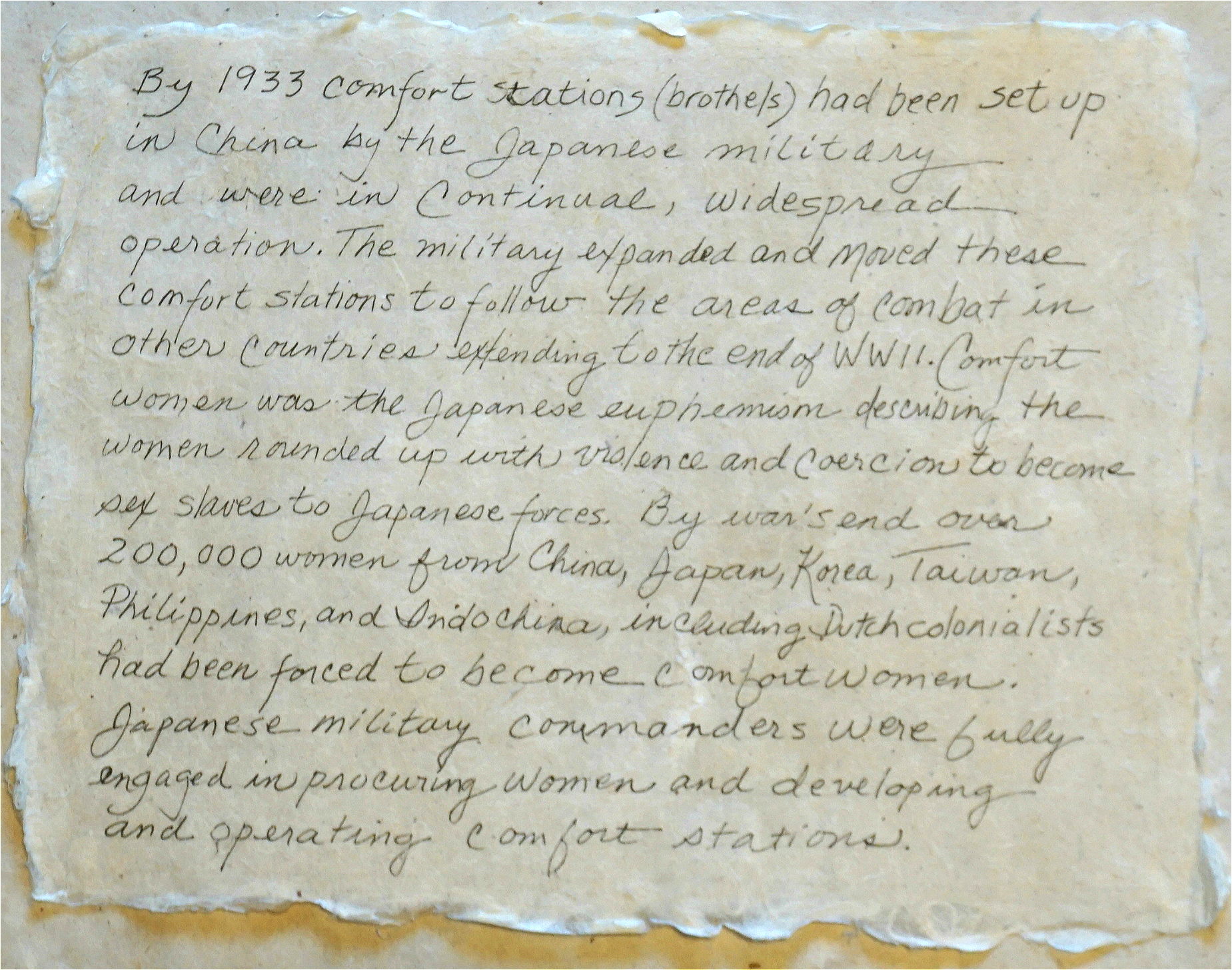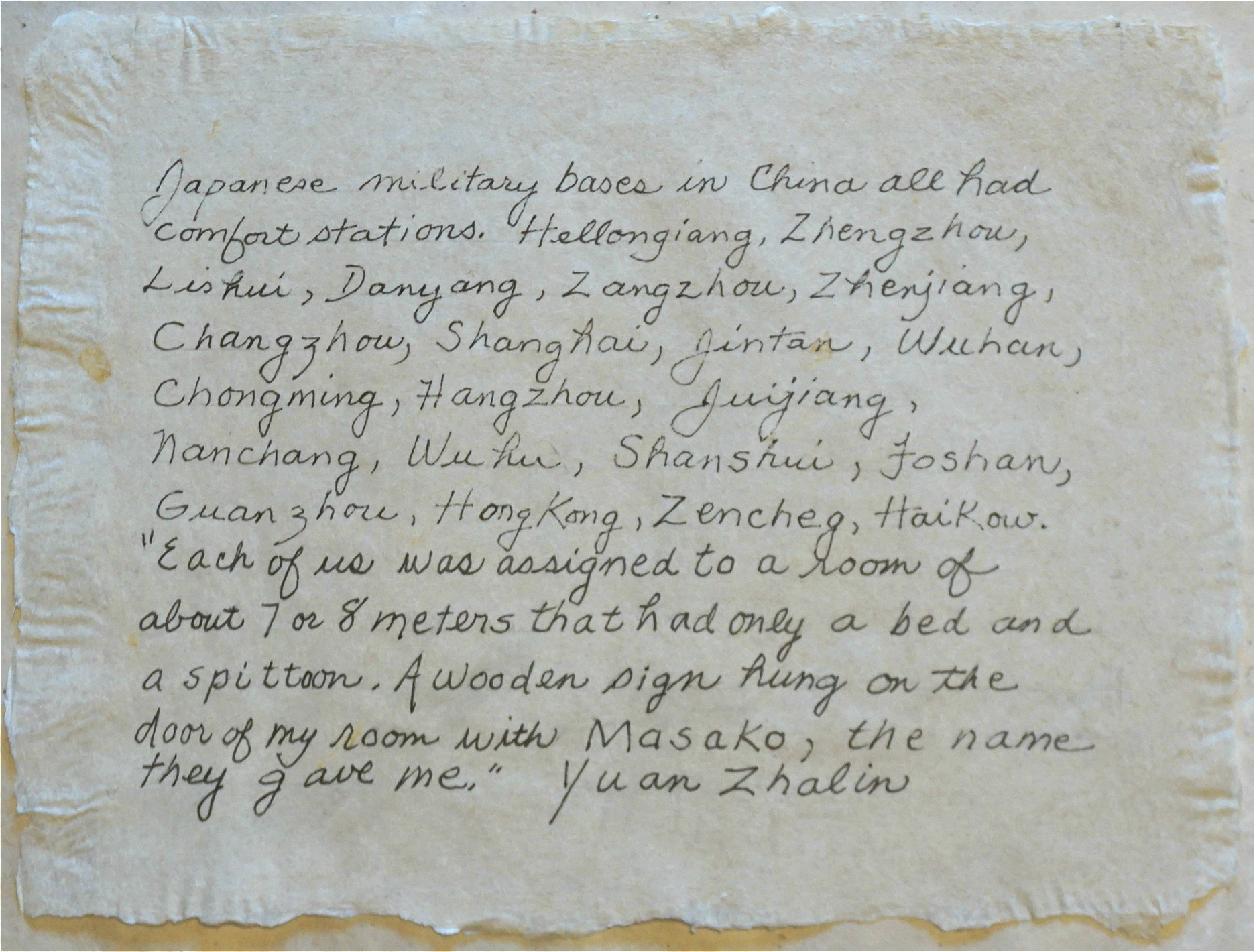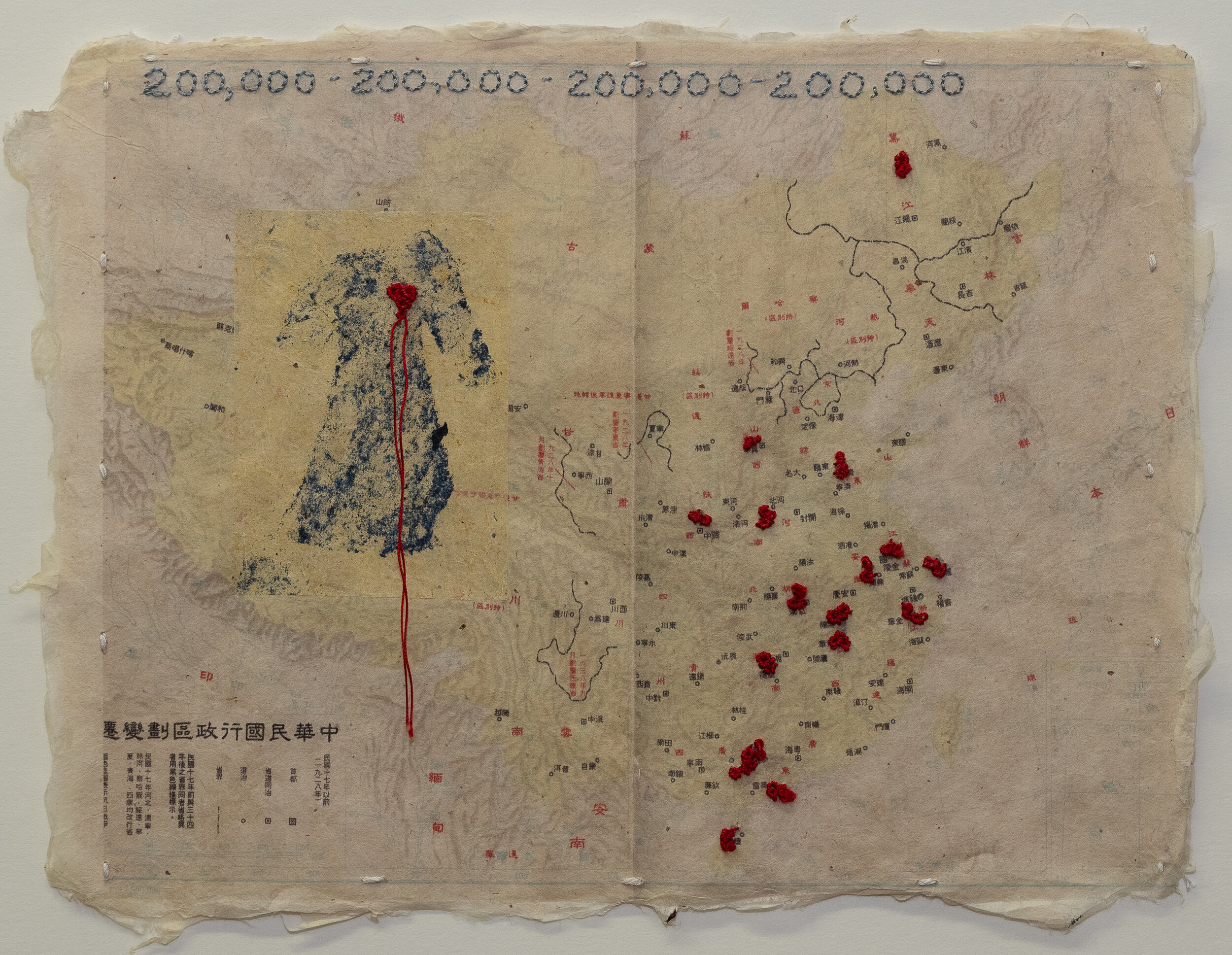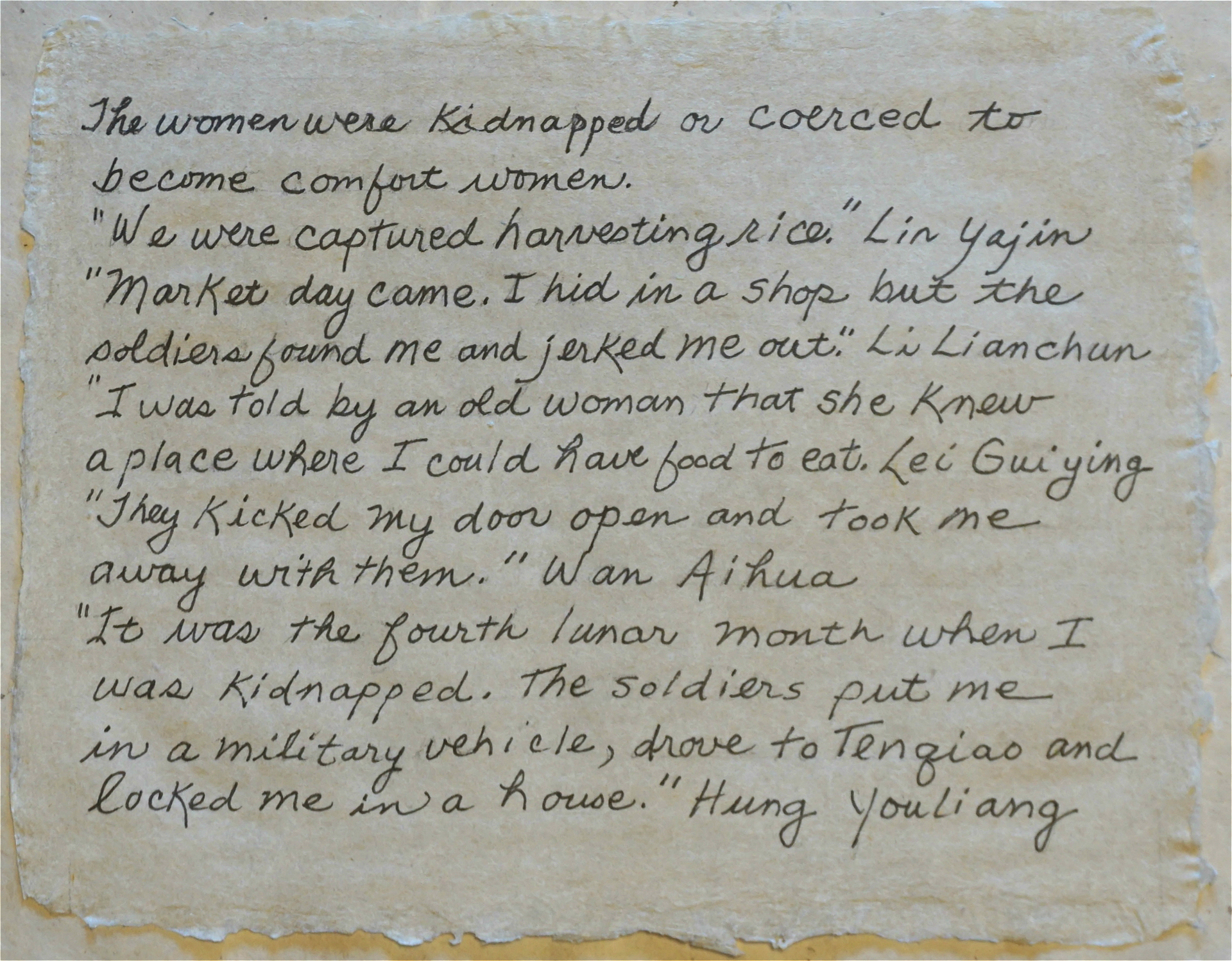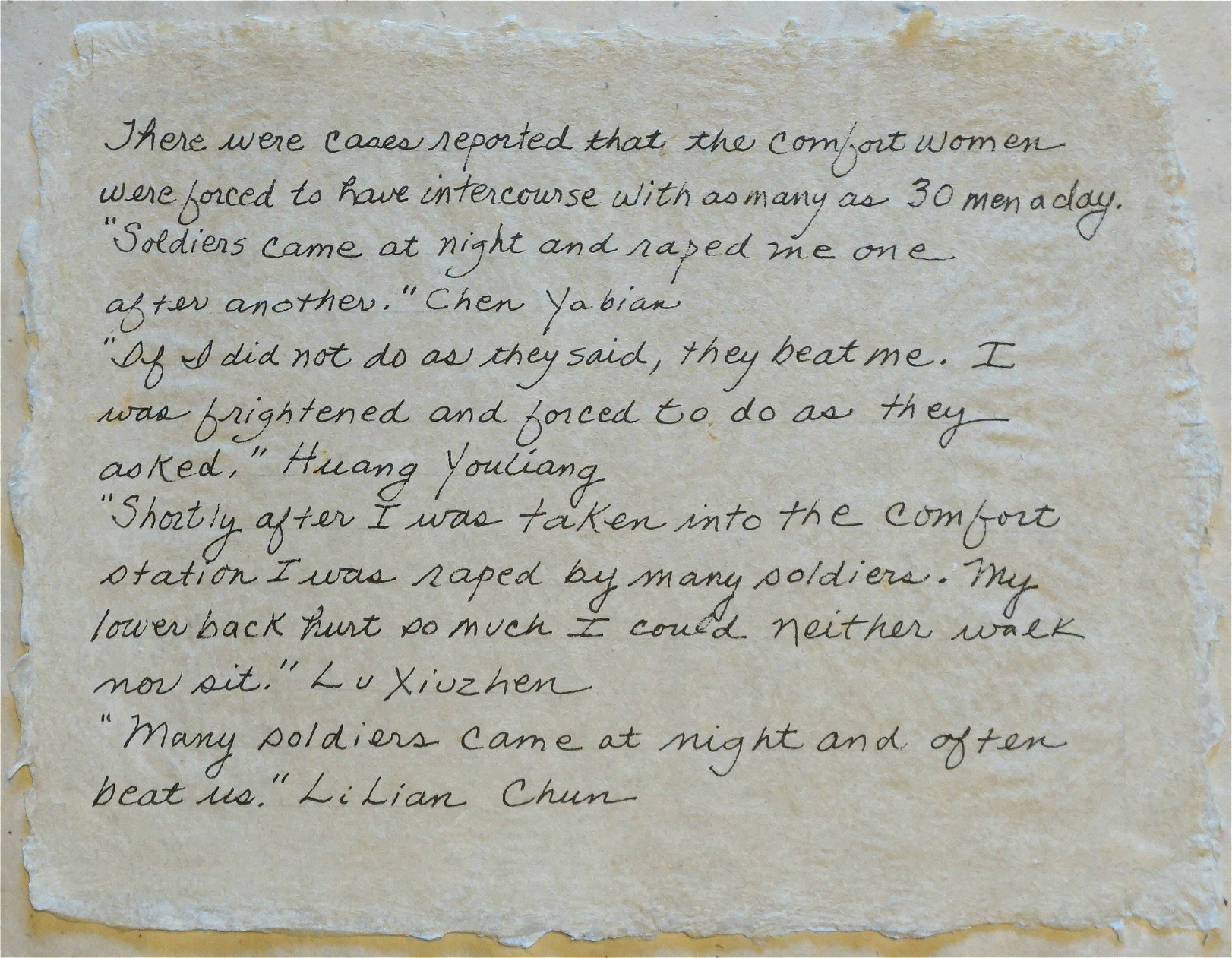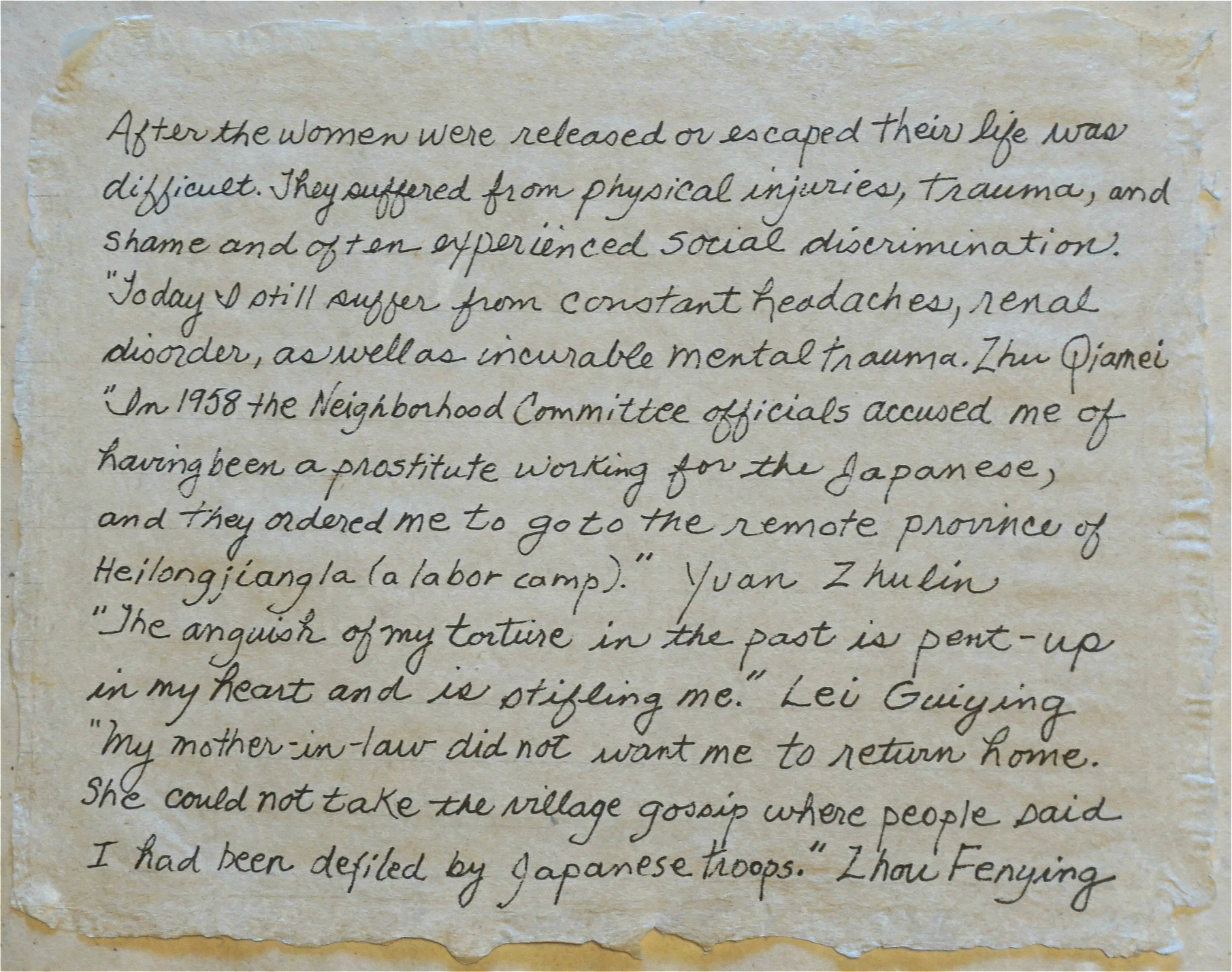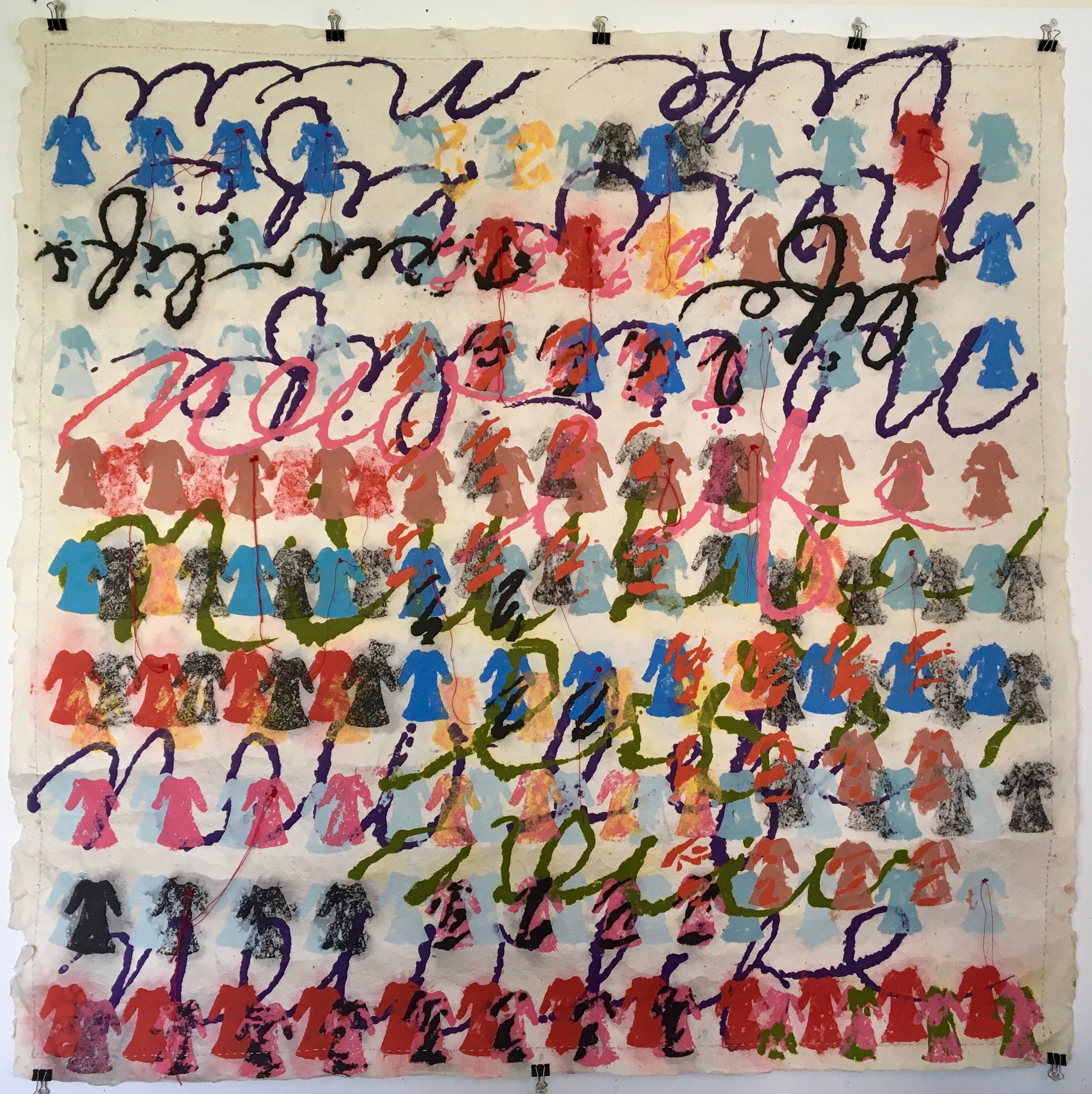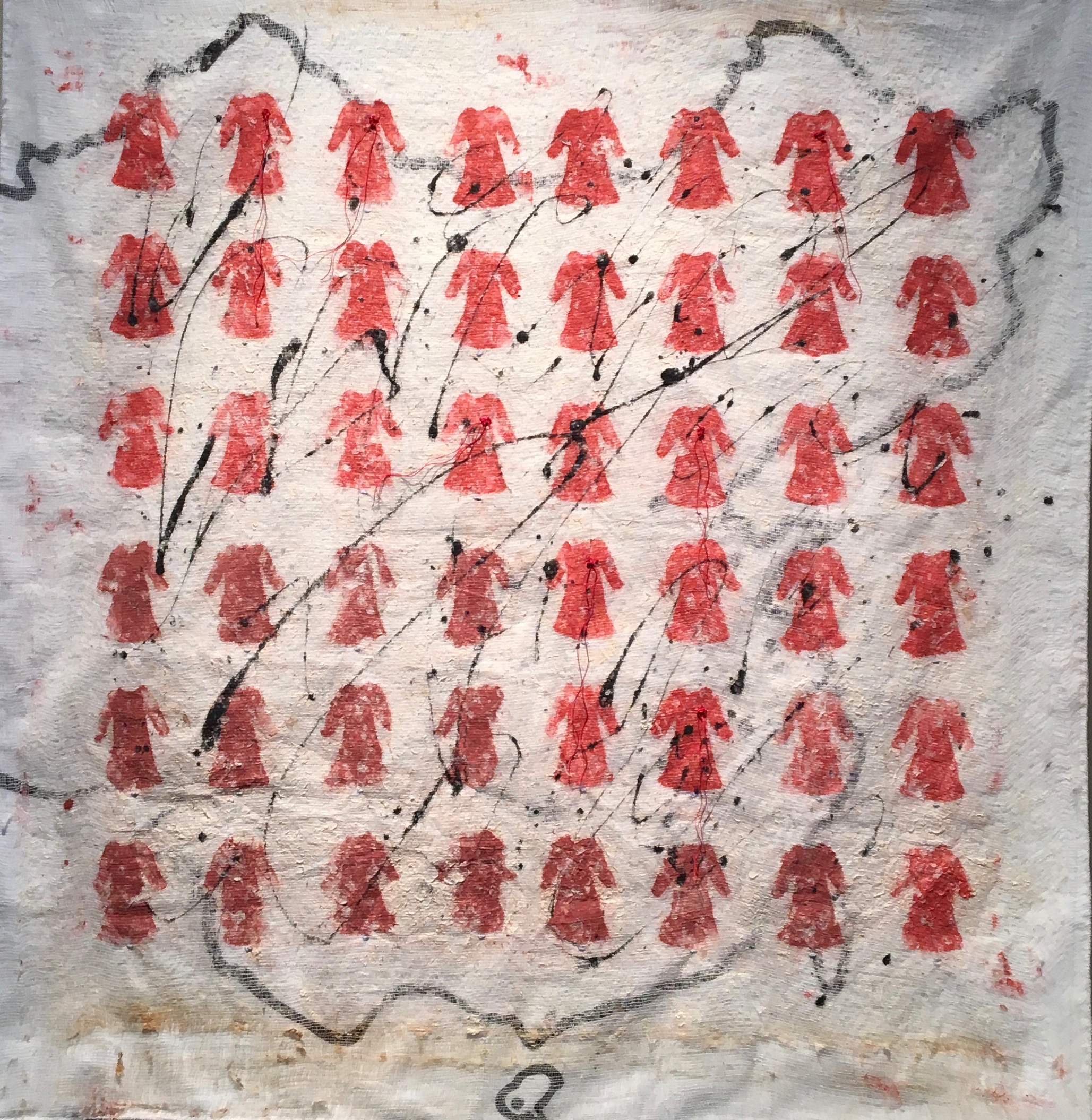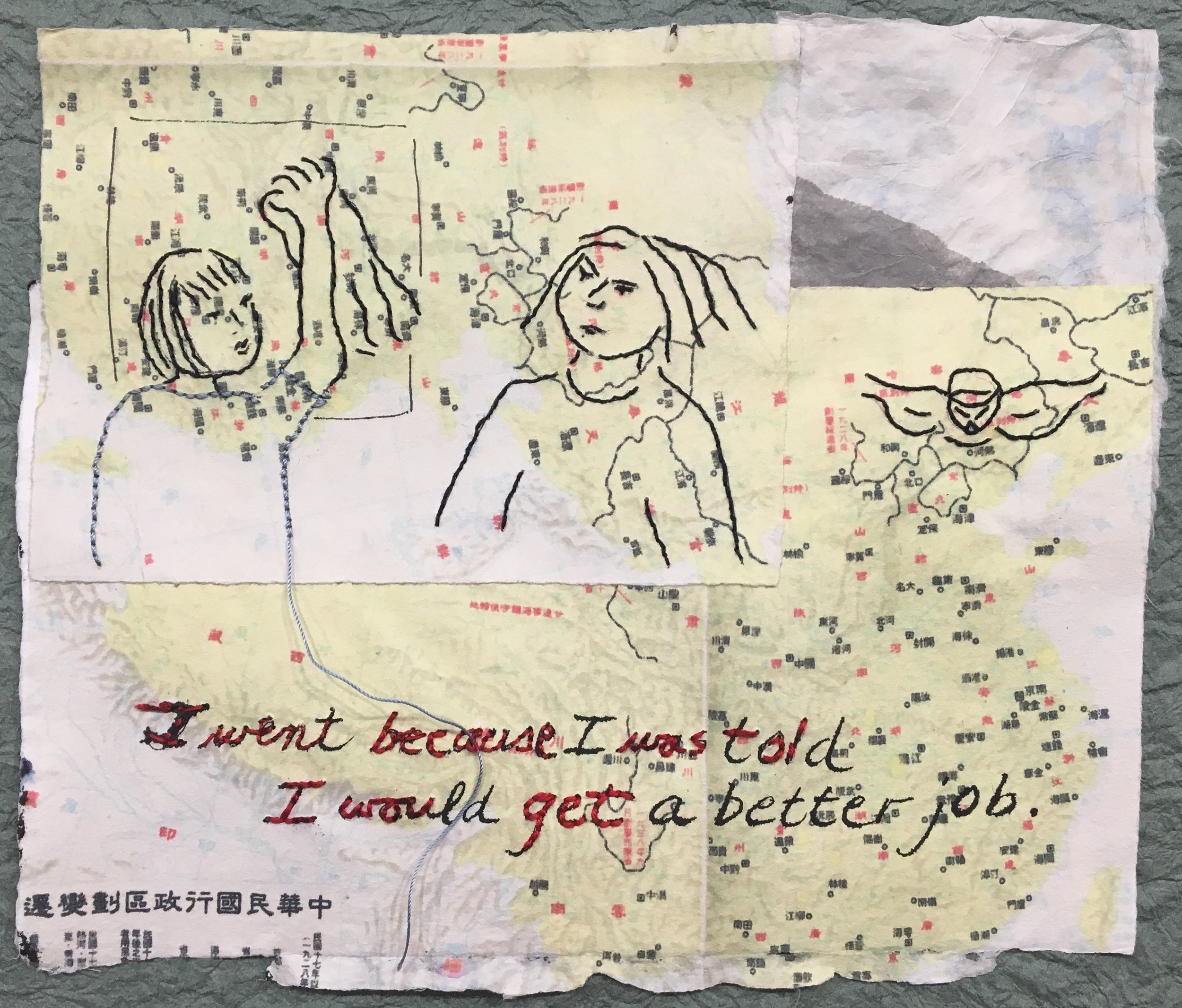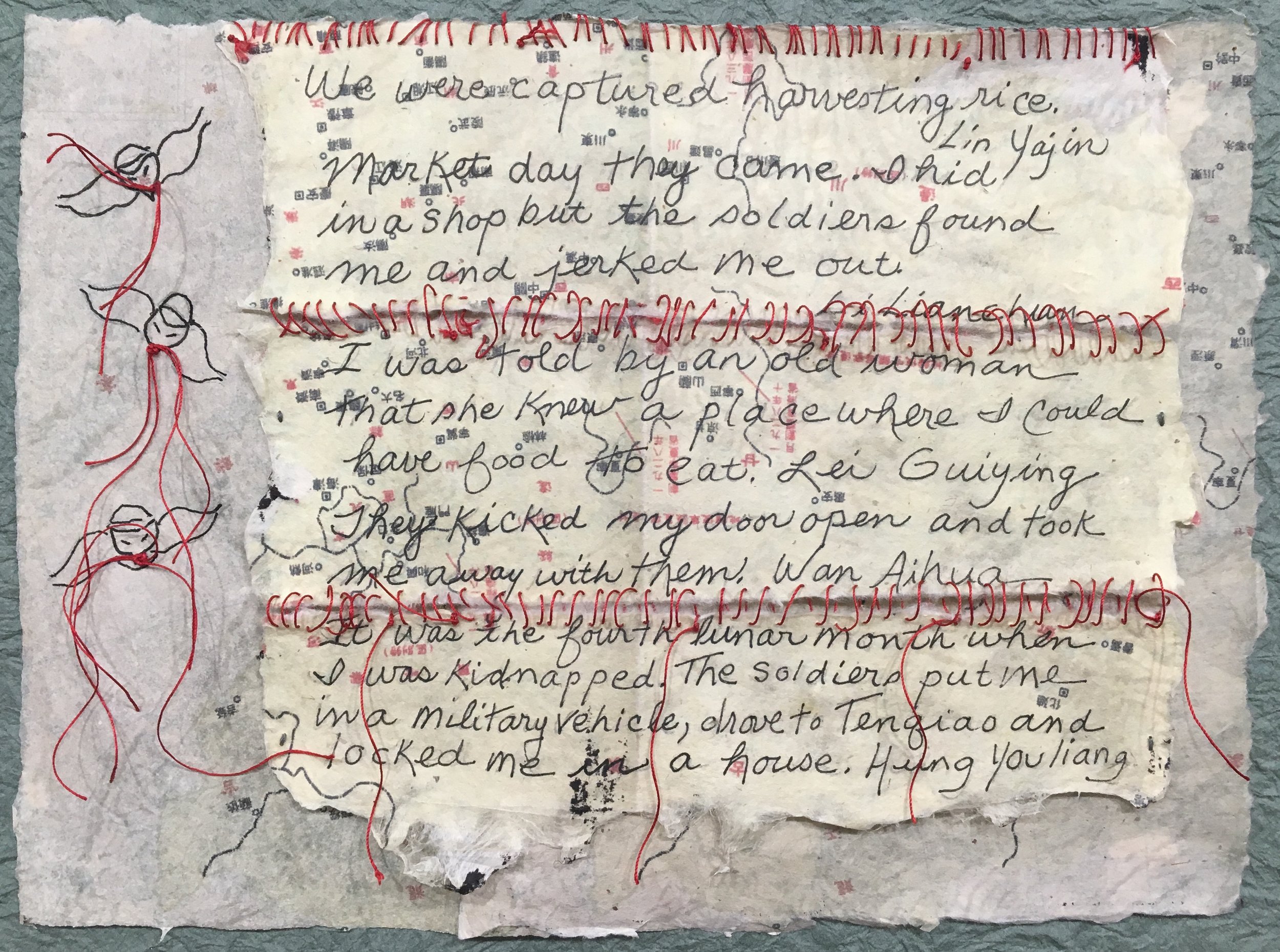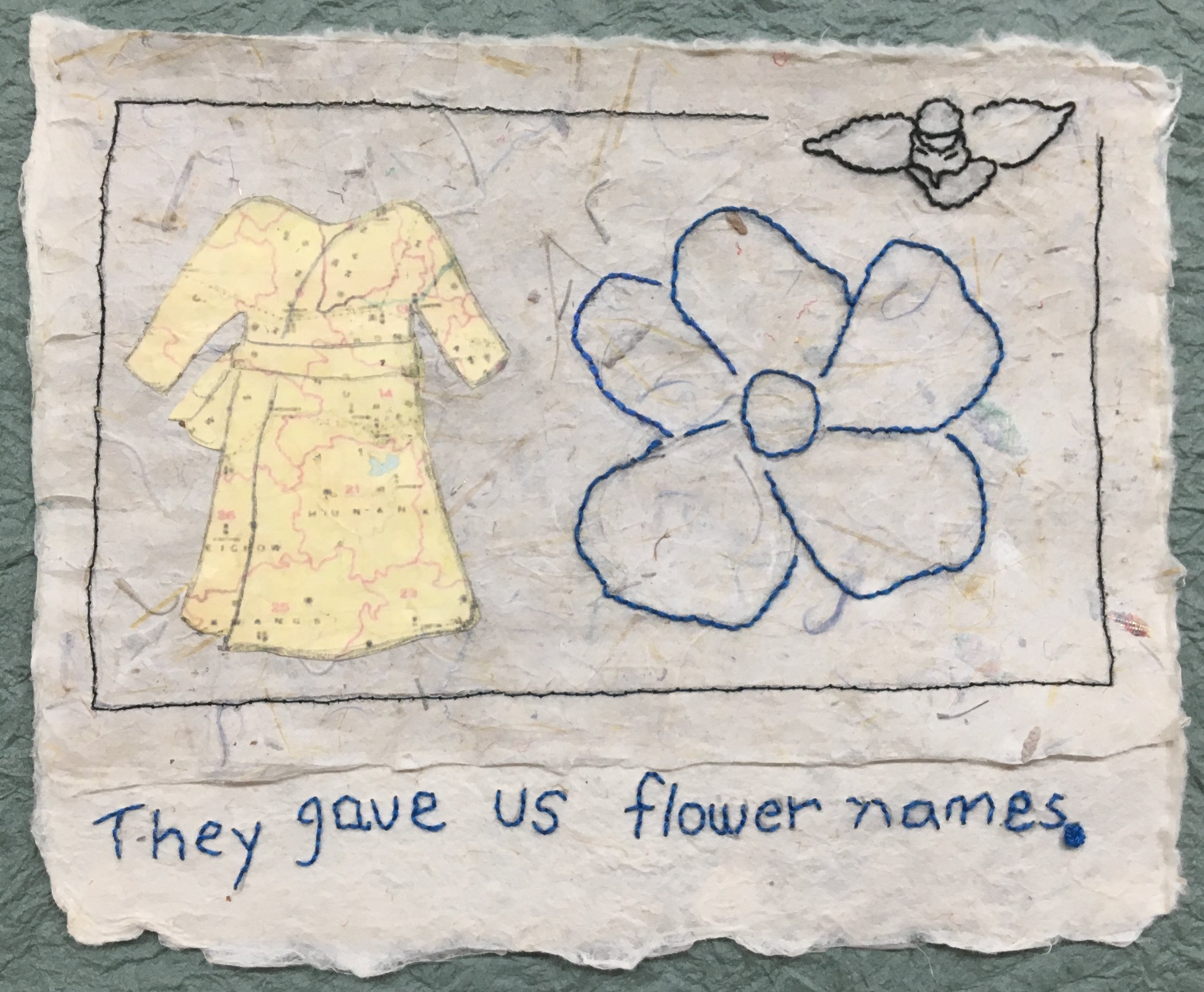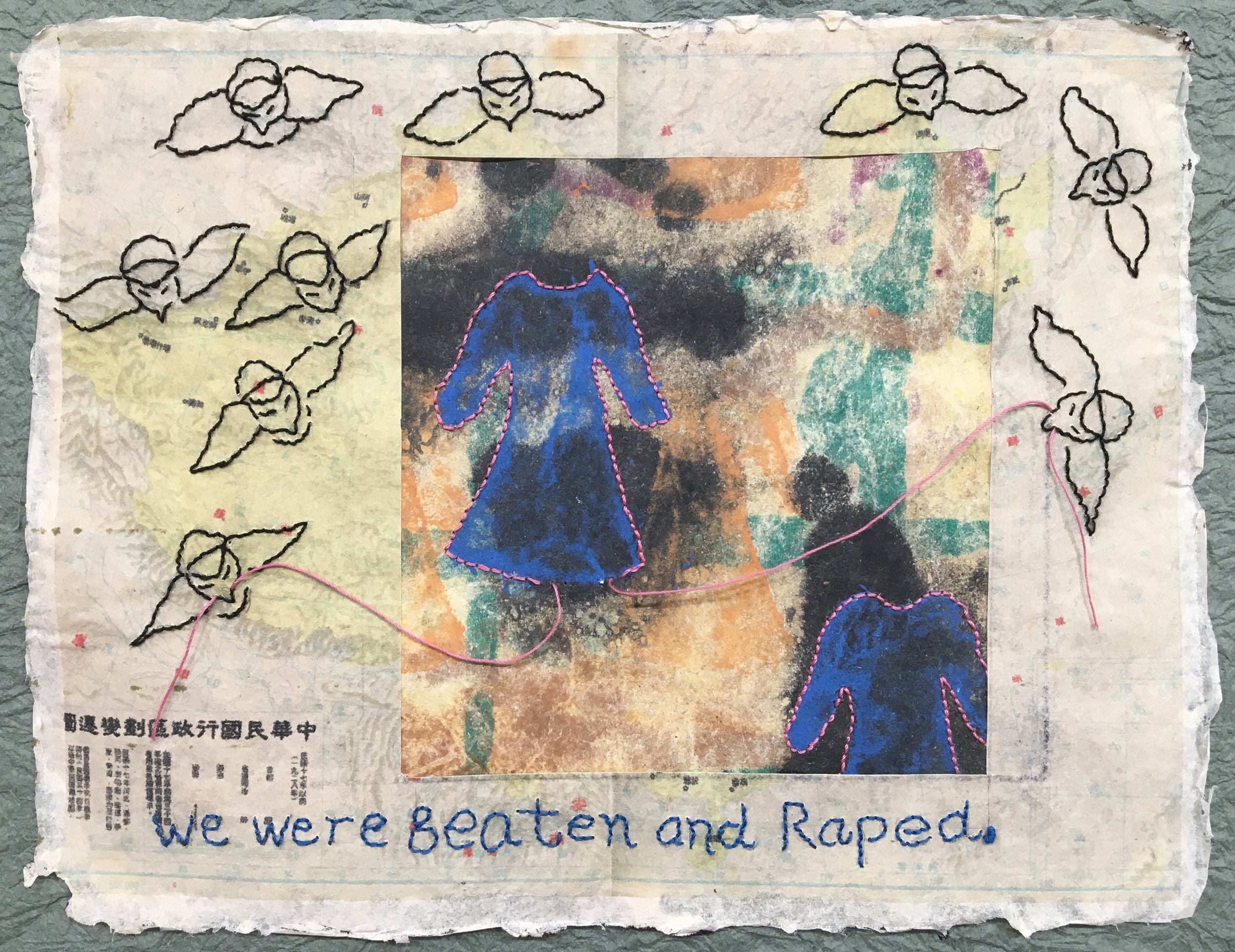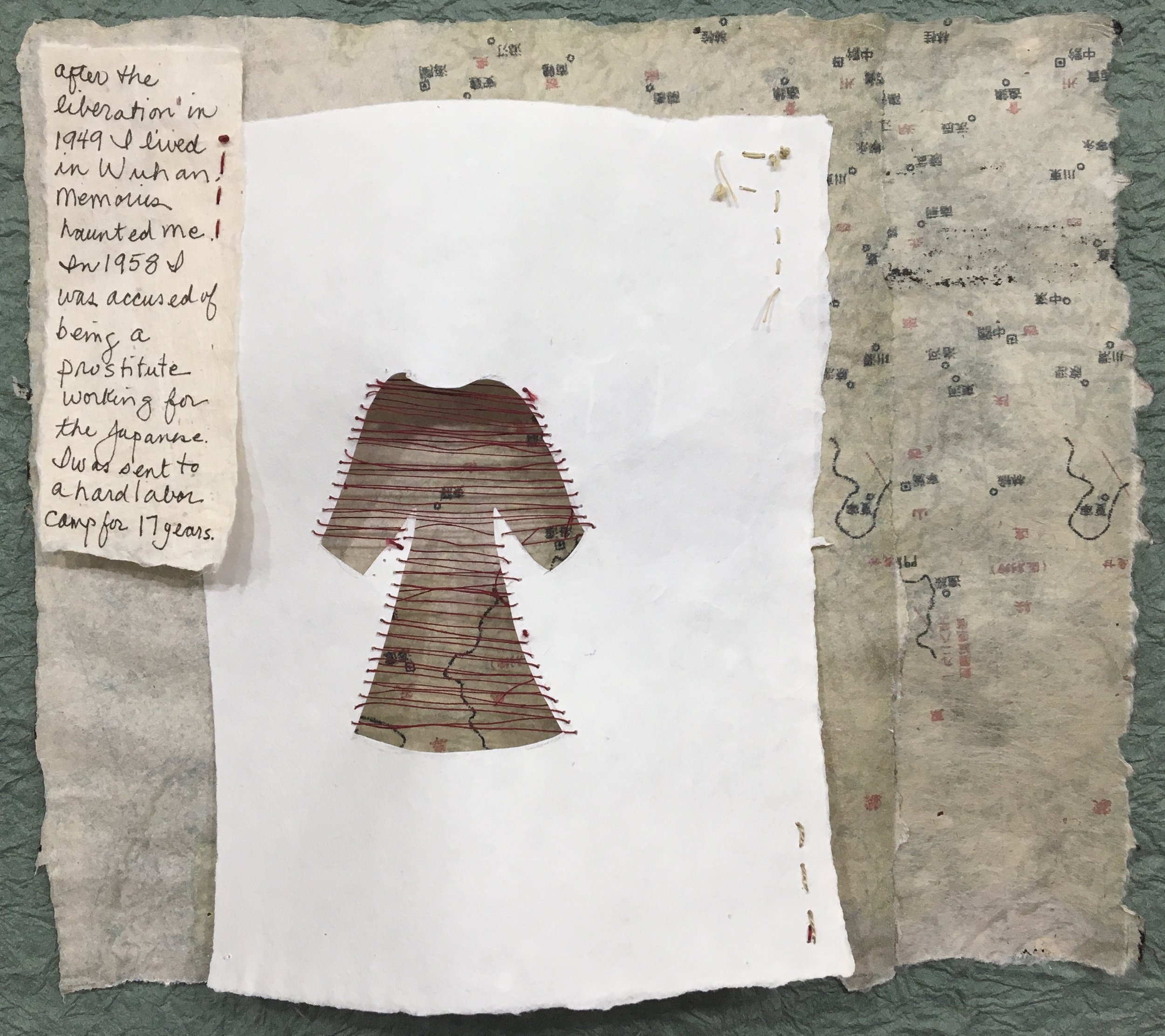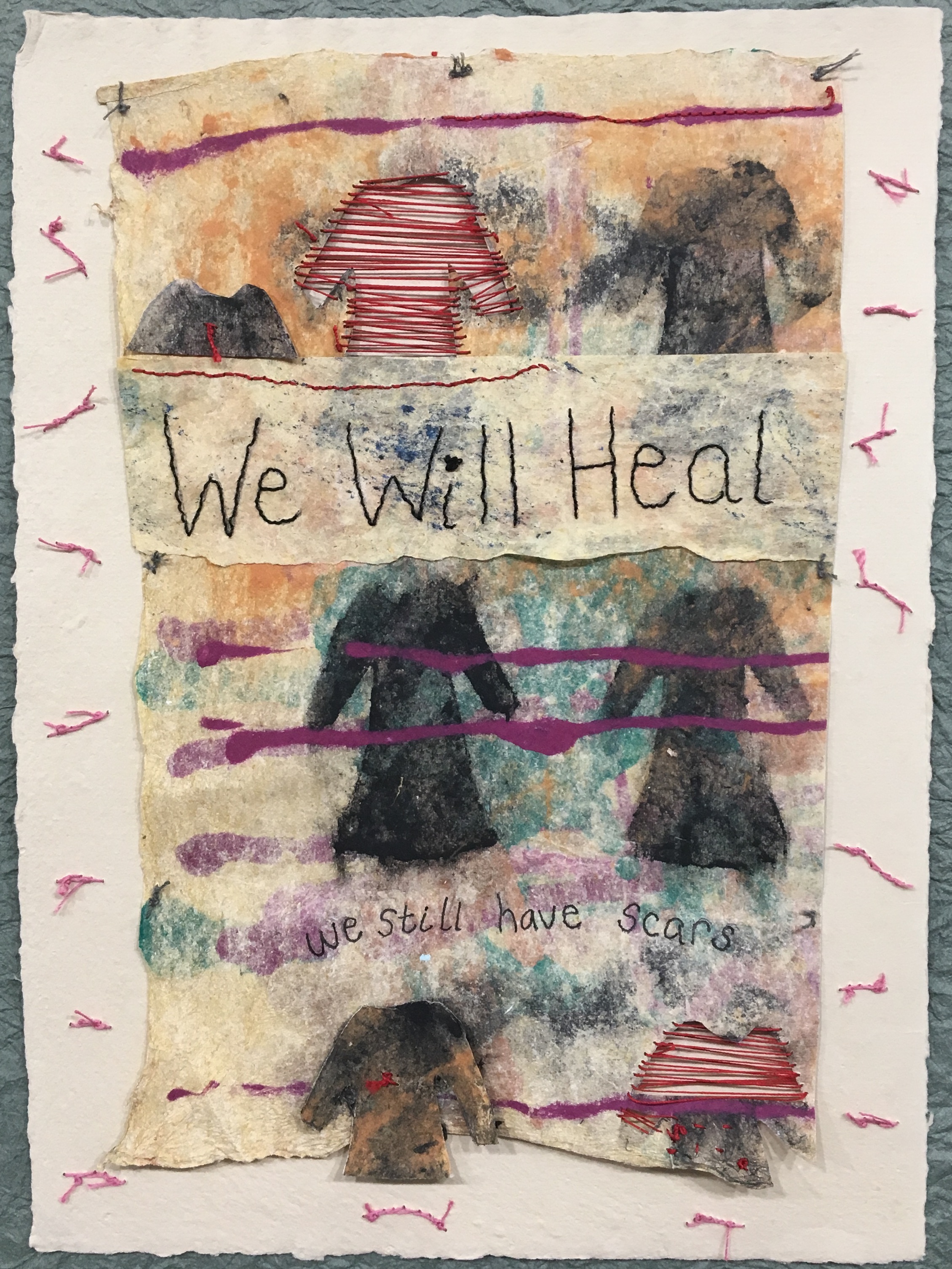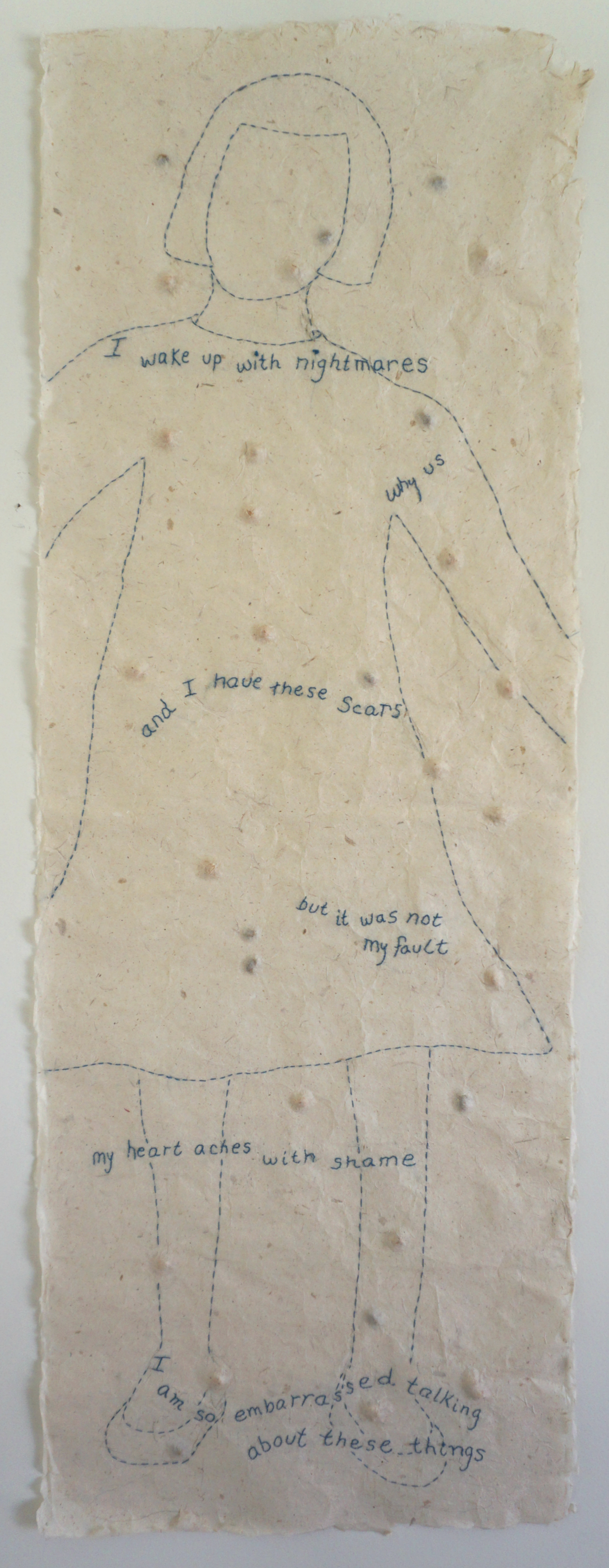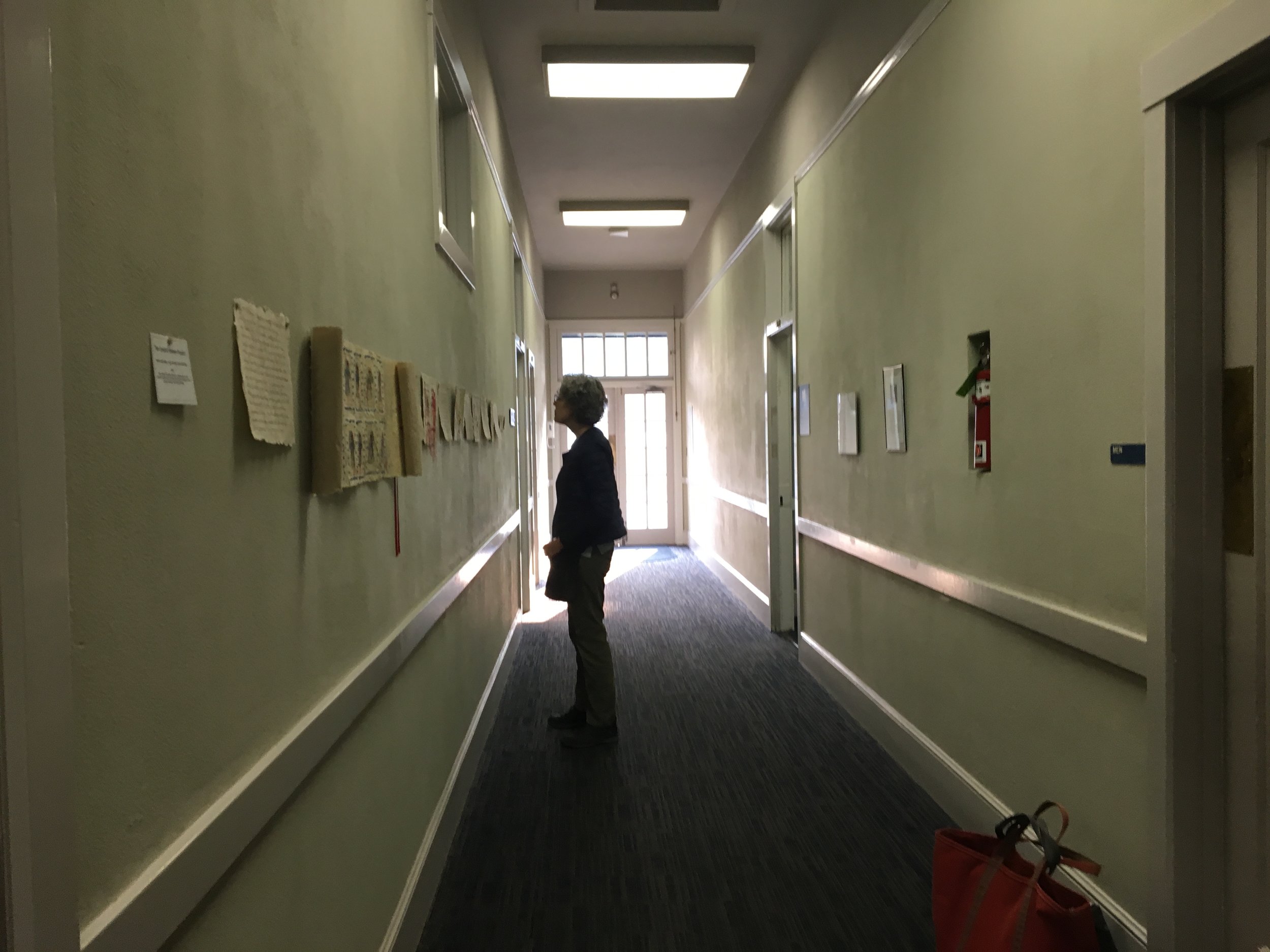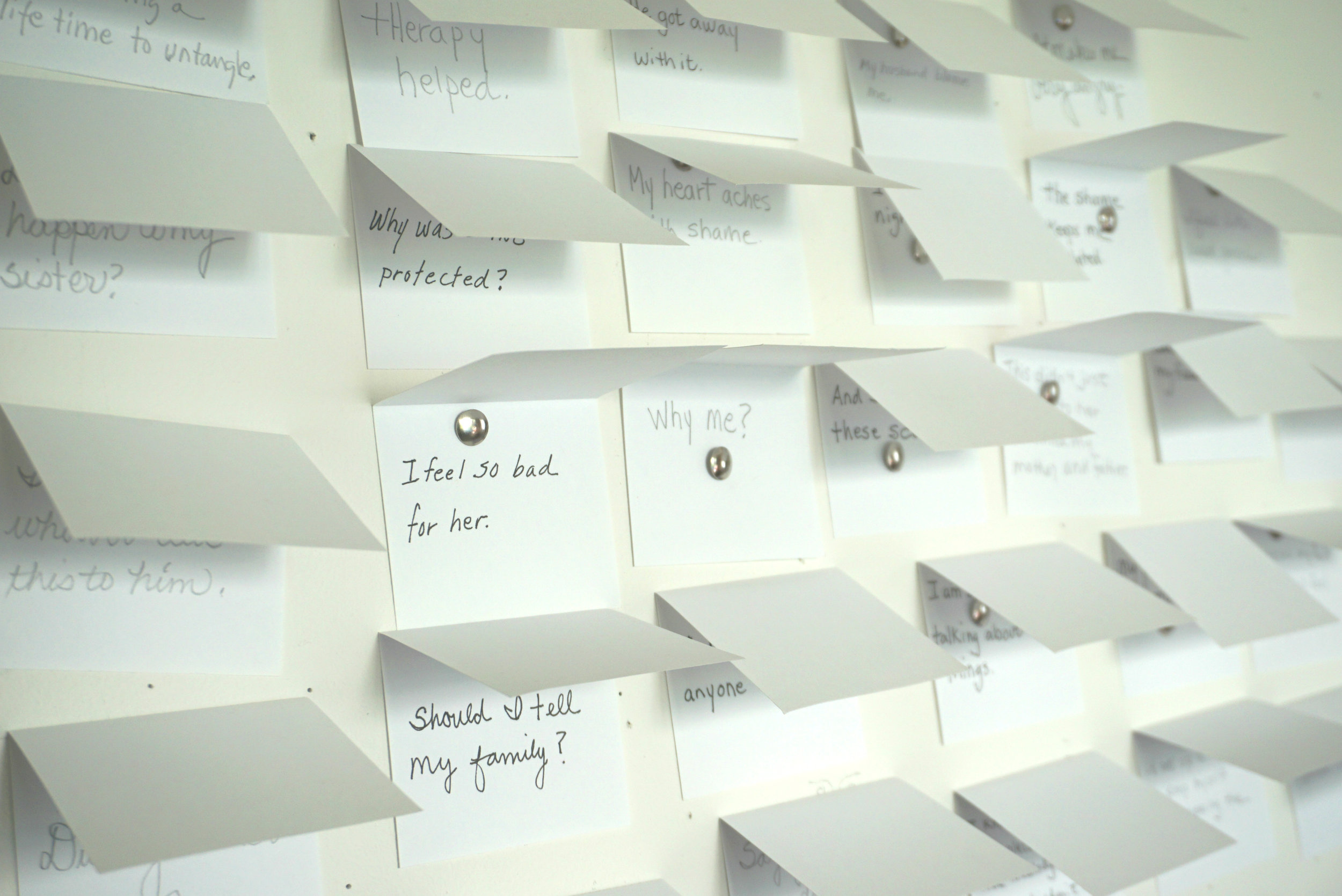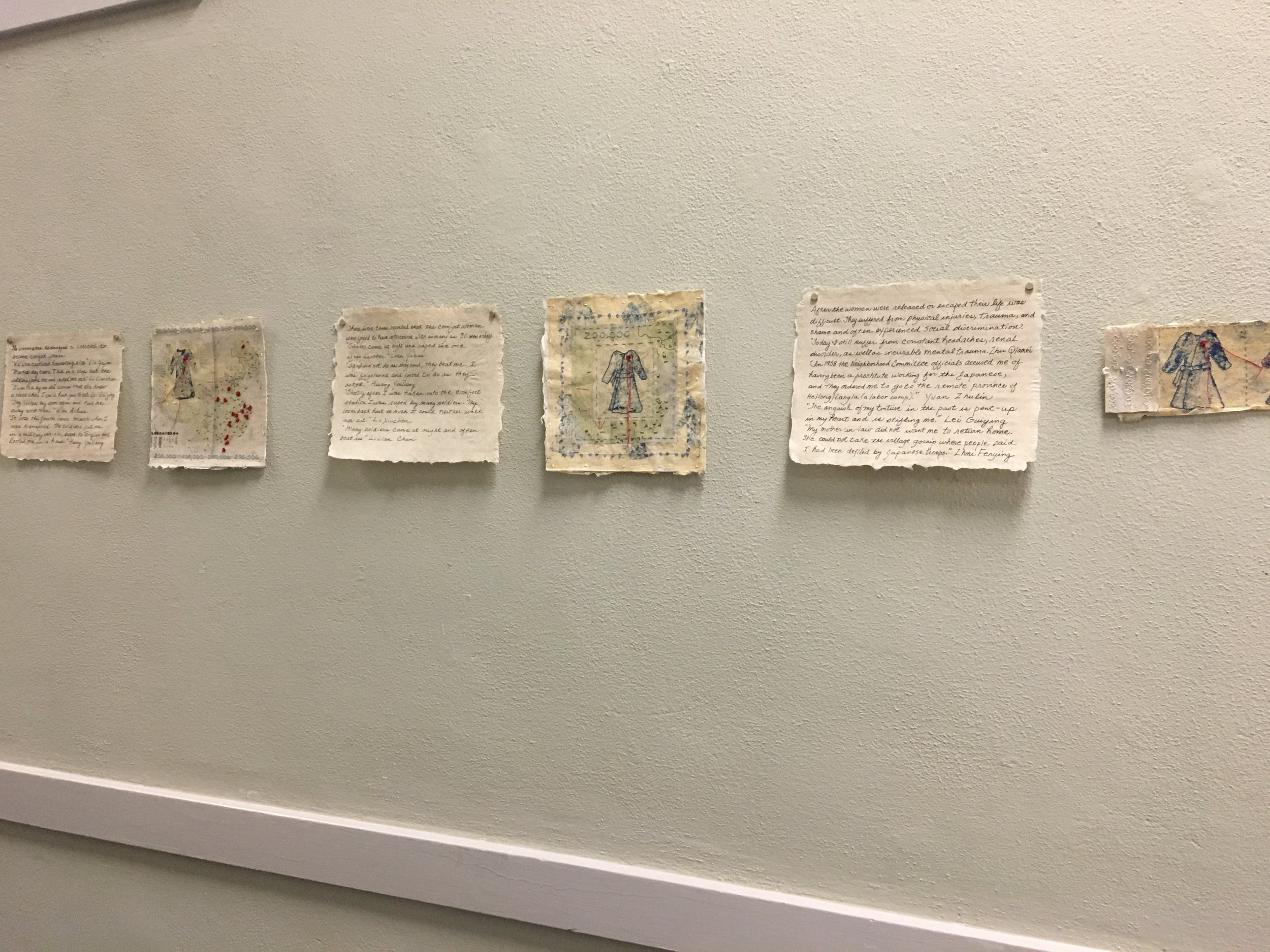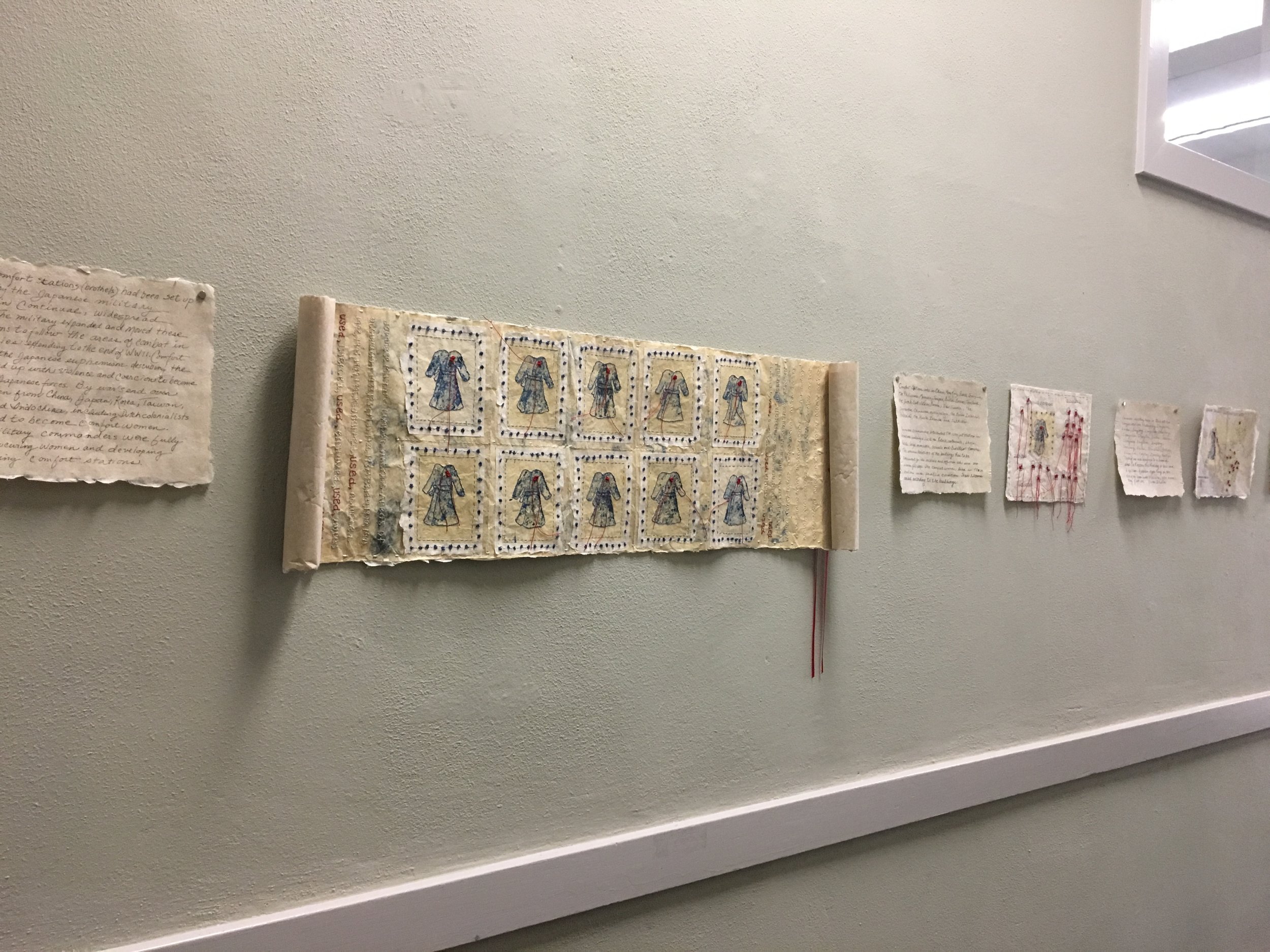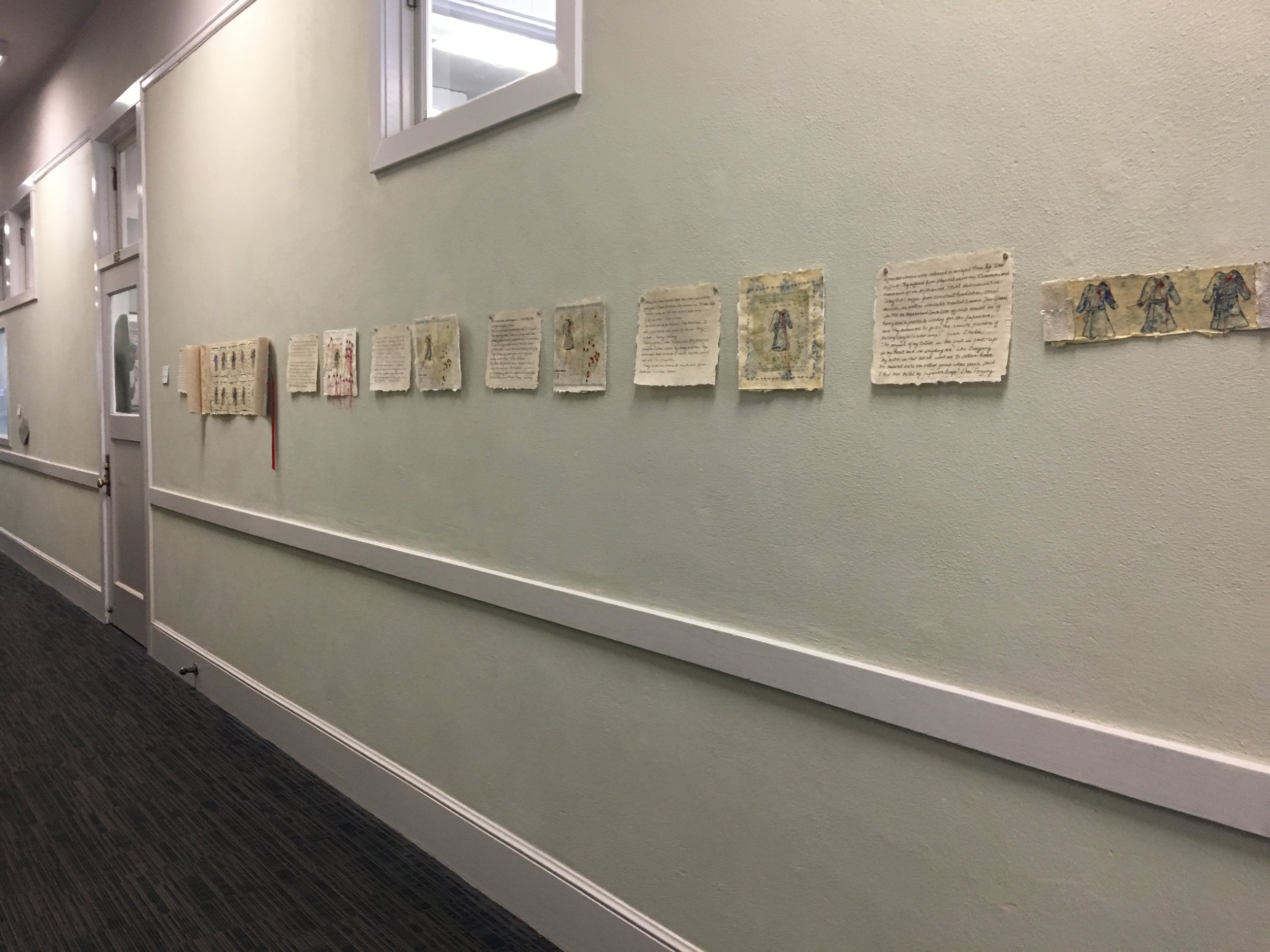The “Comfort Women” Project
Art Exhibitions, Workshops, Discussions
Dedicated to the “comfort women” and all those who have suffered from sexual violence and sexual abuse.
It is hard to escape the common thread of shame and silence about sexual abuse, whether it is as highly organized and brutal as in the case of the “comfort women” in China; perpetrated by men of power in Hollywood, the American news media, and the White House; or secretly done by a father to his daughter in Evanston, Illinois. It needs to be talked about, exposed, and not forgotten.
In 2013, I was invited to participate in the 85 Years 85 Artists exhibit at Menlo College in Atherton, California. Menlo College was celebrating its 85th year with an art exhibition and invited 85 artists to create an artwork to respond to a year during that 85-year time period. We were given a year to make the art for the 2014 exhibition at the college. The topic and medium were the artist’s choice. The year was arbitrarily given.
Jesse Pritchett, our son, had been a university lecturer at Jiujiang University in Jiujiang, China since 2007. In both 2008 and 2009 Jesse facilitated an artist residency for me to work with 20 college freshmen at the university. Each year the students and I worked together to create and perform a performance-art piece. In the fall of 2010, my husband David and I, accepted faculty positions at the university for the fall semester. David taught English language classes and I papermaking and artists books. My 20 art students and I worked in a studio we devised in the faculty housing block where we lived. I spoke little Chinese but my students who knew basic English could understand me. I had a Chinese co- teacher who helped me with the language and the navigation of the university system. My husband and I lived off of the economy, shopped in local markets and ate in the numerous restaurants lining the streets immediately off campus. We made many friends; Chinese colleagues, artists, students and locals. When Menlo College gave me the year 1940, I focused on China.
During that time, “comfort stations” (brothels) had been set up in China by the Japanese military after the Nanking Massacre in1938 and were in continual, widespread operation. The military expanded and moved these comfort stations to follow the areas of combat in other countries extending to the end of WWII.
“Comfort women” was the Japanese euphemism describing the women rounded up with violence and coercion to become sex slaves to Japanese forces. One of these bases was in Jiujiang, where we lived and taught. By war's end, there were over 2,000 comfort stations and over 200,000 women from Japan, China, Taiwan, the Philippines, Korea and Indochina, including Dutch colonialists who had been forced to become “comfort women”. Japanese military commanders were fully complicit in procuring women and developing and operating comfort stations. They kept detailed records. This is a story I wanted to tell.
Making art about horrific subjects requires distance. Being too literal would repel viewers rather than engage them. I approached the art work conceptually looking at all of the elements; the euphemistic “comfort” to describe the women and the comfort that is provided from a quilt: hand sewing and embroidery as women’s work; the robes that the women wore when they were raped, a garment covering a horror; handmade paper, a craft that goes back to the Han Dynasty, 100 BC. The result was a 20”x 18” quilt on handmade paper with hand stitching, and pulp painting.
The research on the “comfort women” expanded. How were the women taken? What went on in the “comfort stations”? How long were the women there? How were they treated? What happened to them after they returned home? I read more books, saw documentaries, read newspaper accounts. Xuemei Wu PhD, professor of history at Zhon University of Economics and Law in Wuhan, Hubei province, China, was particularly helpful in discussing the conditions and culture of the Chinese during the war; her grandparents lived in the mountain hills above Wuhan at that time. I was particularly interested in the negative attitude of the Chinese local governments and citizens toward the “comfort women” once they were released. Commonly they were ostracized and, in some cases, sent to labor camps as a punishment for what the government considered to be consorting with the enemy. As I was invited to participate in other exhibitions; HMS Studios England and Art on Armitage Chicago for their exhibitions in Athens, Greece, Prairie State College in Chicago, Reflect Space in Glendale California, I made work that addressed the trail of the “comfort stations” in China, the “comfort women’s” abduction, coercion, rape, and their lives once they returned home. The medium remained the same; handmade paper, pulp painting, hand sewing and embroidery.
While doing the work I became aware of similarities between statements made by “comfort women” survivors and present survivors of sexual violence. It was hard to escape the common thread of shame and silence about sexual abuse, whether it is as highly organized and brutal as in the case of the “comfort women” in China; perpetrated by men of power in Hollywood, the American news media, and the White House; or secretly done by a father to his daughter in Evanston, Illinois. It needed to be talked about, exposed, and not forgotten.
And talk about it we did. I returned to Menlo College for an artist residency in the fall of 2018. To accompany my “Comfort Women” Project exhibition at the college, a group of students and I created an interactive installation for the student body, faculty and staff to participate in the at the library. Message Board held comments about feelings about sexual violation. This might be about themselves “My heart aches with shame.” “It set up a system to keep myself from seeing the truth.” “I don’t want anyone to know.” “I wake up with nightmares.” It might have been about others. “This didn’t just happen to her, it killed my mother and father.” “I want to hurt whoever did this to him.” “My husband blames me.” The notes were folded and thumb tacked inside so that they could be opened to read. This large bulletin board had accompanying boards where students posted newspaper and magazine articles about rape, sexual violence toward men women as well as the #Metoo movement. The librarians filled a large table with books about sexual abuse and violence.
Students organized an evening of conversation for the college and community. They had experts talk about the history of the “comfort women” and the trauma resulting from sexual violence. A student spoke about the #Metoo movement, a Menlo professor read her poetry, a student presented a spoken word piece. Before we started a sound piece by students reading comments from the installation was played. We ended with an open discussion.
I returned home to complete the artwork that I started during the residency. It focused on statements made by individual “comfort women” and has been added to the body of work. The “Comfort Women” Project has moved on to other venues, more art making, more discussions. Yes, there is the common thread of shame and silence about sexual abuse. Scars remain but healing is possible.
ART NOTES
The dress images were taken from sketches of robes that the “comfort women” wore when they were forced to provide sex for the military men. The map used is a copy of an original 1937 map of eastern China. The red french knots in “Comfort Women” Quilt Map and Comfort Stations in China mark the locations of the comfort stations in eastern China. The text quotes are from Chinese “comfort women”. Chinese “Comfort Women”, Testimonies From Imperial Japan’s Sex Slaves, cited above. All works are on handmade paper with pulp painting made by Rose Camastro-Pritchett at the Center for Book & Paper Arts, Chicago.
“COMFORT WOMEN” PROJECT EXHIBITIONS
2021 The Comfort Women Project, 1100 Florence Gallery, Evanston, IL 2021 Embodying Justice, Awakenings Gallery, Chicago, IL 2019 Chicago Artist Platforms, Platforms Project Net, Athens, Greece 2018 The Comfort Women Project, Menlo College Gallery, Atherton, CA 2018 Altered, Christopher Art Gallery, Prairie State College, Chicago Heights, IL 2018 Do the Right Thing! Reflective Space Gallery, Glendale Library, Glendale, CA 2016 Precious Little, Harrington Mills Studios, Platforms Projects, Athens, Greece 2014 85 Years, 85 Artists, Menlo College Gallery, Atherton, CA 2014 Not Quite Lysistrata, Art on Armitage Gallery, Platforms Projects, Athens, Greece 2014 Social Paper, Center for the Book & Paper Arts, Columbia College, Chicago, IL
THE “COMFORT WOMEN” PROJECT WORKSHOPS AND DISCUSSIONS
2021 The “Comfort Women” Project, 1100 Florence Gallery, Evanston, IL 2018 The “Comfort Women” Project, Menlo College, Atherton, CA
PRESS
Interview with Awakenings Gallery Creative Director, Jeri Frederickson https://www.youtube.com/watch?v=7gL3Fr1sAXU In Menlo, https://inmenlo.com/2018/10/24/artist-rose-samastro-pritchett-brings-comfort-women-project-to-menlo-college/
Menlo Advantage Magazine: https://issuu.com/memlocollege/docx/menlo-advantage- winter-advantage-winter-2019 pages 39 - 40 Awakenings: https://awakeningsart.org/issue-10-intention-for-change/
LINKS
Education for Social Justice Foundation: http://www.e4sjf.org/
1100 Florence Gallery: https://www.1100florence.com/
Platforms Project: Platformsproject.com
Awakenings: https://awakeningsart.org/issue-10-intention-for-change/
Dream Idea Machine FAQ NET: Part VIII: http://www.dreamideamachine.com/en/?p=58545

